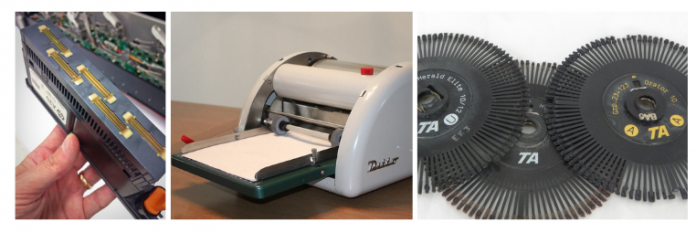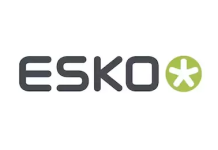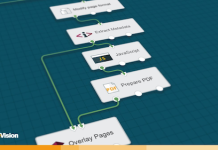According to Focus Label Machinery, the basic analogue printing processes used by businesses worldwide are fundamentally the same as those developed in the 17th century, and many businesses still depend on less efficient flexographic machines purchased in the ’90s or early noughties. This doesn’t mean, however, that print businesses can rest on their laurels and avoid investing in innovation, because obsolete print technology is as much a problem for the sector as obsolete machinery in any other industry.
The latest flexo machines integrate digital technology through drives and software, providing live management information, stored job details, automated set ups, improved quality and productivity. Although the physical hardware of print technology evolves fairly slowly (although it does change), since the dawn of the digital age, the software and control systems that power this equipment have changed at a rapid pace – in line with other computerised systems. As such, the obsolescence window for print software and digital control systems is around 18 to 36 months, while digital hardware itself should be upgraded every 3 to 5 years.
The graveyard of the print sector – obsolete print technology
Whilst some technologies evolve – such as flexographic printing – others become completely obsolete. The following three technologies are classic examples of obsolete print technologies that were once ubiquitous and, indeed, cutting-edge, but are no longer used commercially today.
1) Dot Matrix printing press
Dot matrix printers used a series of pins to form a dot, with multiple dots combined to form characters and images. These printing presses were developed in the 1970s to increase the speed and quality of newspaper and book printing as well as the range of typefaces and the durability of printed material. They went a long way to reducing the cost of printed media and expanded the applications of printed media into sales and marketing, with positive economic effects. However, dot matrix printers became obsolete almost overnight when inkjet printing presses became more affordable in the 1990s, providing businesses with a better quality, faster and less noisy print solution, with superior colour matching and lower energy expenditure.
2) Daisy Wheel printing press
Daisy wheel printers were another innovative print technology from the 1970s that used metal characters (carried over from the traditional typeset printing method, still used until the late 1990s in some businesses) and ink ribbons to impose letters and images onto a substrate. The quality was high compared with early dot matrix solutions and they were comparatively fast – with some machines printing 30 characters per second – but could only cope with printed characters, not images. As the demand for mixed media printing increased during the 1980s, daisy wheel printers failed to keep up and were quietly phased out.
3) Mimeograph printing
Mimeograph printing is a classic story of an advanced printing technology that led the industry for almost a century before fading into complete obscurity. Today, not many people have heard of mimeograph printing, let alone know what a mimeograph machine looks like. Essentially, a mimeograph machine carried out the same function as a photocopier, by impressing ink onto a substrate through a stencil to form an image. It operated using a rotary print drum, which fed the substrate between the drum and roller, and was capable of producing hundreds of high-quality stencilled documents every minute.
Mimeograph printing was replaced during the 1960s by true photocopiers – which were cheaper to use and more efficient – and offset lithographic printing. It could be argued that both photocopying and lithographic printing are also approaching obsolescence due to the widespread availability of cheap digital printing presses.
Learning the lessons of history
Obsolescence is the price of progress and every investment in technology has a finite shelf life. However, no business wants to invest in technology that will rapidly become obsolete, so when planning investments, care should be taken to compare the relative long-term values and cost of ownership for different options.
The more a technology is capable of upgrading, the less likely it is to become obsolete and the better ROI you will get from investing in it. Analogue technologies such as the mimeograph, dot matrix and daisy wheel printers were extremely vulnerable to obsolescence because they could not be upgraded or updated at all. As soon as a more efficient technology was invented, the older solutions became worthless.
This is an important lesson to consider for businesses who still use analogue print technology, including flexographic and lithographic presses. Flexographic presses have responded well to the demands of the modern sector and can be retrofitted with a variety of advanced control systems that have improved quality and productivity. However, digital-flexo presses are far more amenable to upgrade than their mechanical-analogue counterparts and are subsequently more resilient to change.
A good example of this is the new generation of hybrid presses, which, although often marketed as flexographic solutions, are in fact digital presses developed to mimic the key advantages of flexographic printing with the benefits that a digital print engine can bring. In this case the print engine can be upgraded whilst the web transport remains, extending the ROI.
Investing in technology brings both risks and opportunities for businesses. It’s impossible to avoid investing in new tech, as this risks your business falling behind its competitors, but when seeking finance for new investments, it’s crucial to compare both the short and long term returns from new technologies, and make a decision based on the total cost of ownership.
FOCUS LABEL MACHINERY
jamesb@focuslabel.com
https://www.focuslabel.com





















